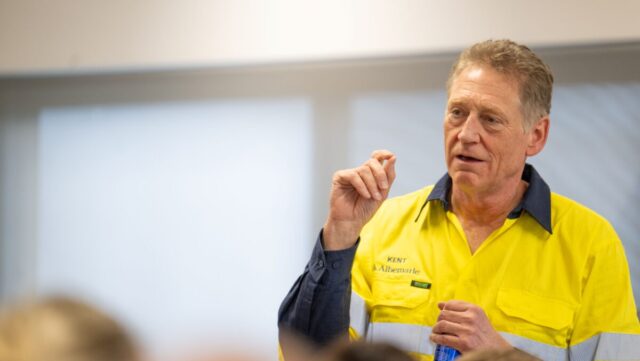- Albemarle boss Kent Masters has used a flying visit of WA to trumpet a bullish outlook for lithium demand
- Customer needs will surge 5x to 3.7Mt LCE between 2022 and 2030, with expanded Kemerton refinery to feed 2.4m EVs annually
- IGO reveals staggering 640% lift in dividends as Greenbushes stake turns into ATM
We’ve seen any number of wild and woolly projections on lithium demand out to 2030 and beyond.
Sprott sees a CAGR of 16-20% between now and 2030, something that equates to a growth of around three times on 2022 numbers.
But some industry figures, including the world’s biggest lithium producer Albemarle, believe demand by the end of this decade will be even higher.
Conducting a flying tour of WA this week, where Albemarle is overseeing a more than US$1.5b construction program to turn its 50,000tpa lithium hydroxide plant in Kemerton into a monster 100,000tpa chemical factory, expected to be the largest outside China.
Having only completed the first two trains at the project near Bunbury last year, what prompted Albemarle to jump early at the plant, expected to produce enough battery grade lithium once fully ramped up to supply 2.4 million EVs a year?
A nearly 500% increase in lithium carbonate equivalent demand in just eight years.
“The decision reaffirms our commitment to our operations in Australia and further points to the confidence we have in our local team at Kemerton to expand from two processing trains to four,” Albemarle boss J. Kent Masters said.
“Albemarle forecasts a nearly five-fold increase in global lithium demand from 800,000 million tonnes in 2022 to 3.7 million tonnes in 2030, and the business is acutely aware of the importance of Australia in helping to meet that demand.
“Looking to the future with respect to technology, we are focused on refining process technology within our core business and on the development of new advanced materials –
particularly in batteries, and battery materials recycling.”
Australia moving on refining capacity
Albemarle, which owns 49% of the Greenbushes mine near Bridgetown in WA’s South-West — the world’s largest lithium operation — as well as 50% of the Wodgina mine in the Pilbara alongside Mineral Resources (ASX:MIN), is not the only Aussie lithium player building out processing capacity locally.
Its 51% partner in Greenbushes, Tianqi Lithium Energy Australia — a JV between China’s Tianqi and ASX-listed miner IGO (ASX:IGO) — is currently commissioning a 24,000tpa plant in Kwinana using its share of the concentrate from the 1.5Mtpa spodumene operation.
But ramping up to produce on-spec battery grade lithium hydroxide has been hard. IGO revealed in its quarterly results last month that the first train delivered just 142t (1/40th of its nameplate capacity) in the June quarter.
It only expects to hit half of nameplate by year’s end, with a decision to expand via the construction of a second train due next year.
Also due for delivery in 2025 is Wesfarmers (ASX:WES) and SQM’s Covalent Lithium refinery in Kwinana, to be fed by the Mt Holland mine near Southern Cross discovered seven years ago by Kidman Resources.
At full scale around 15% of Australia’s spodumene would be refined locally by 2024-25, the Department of Industry, Science and Resources says.
But with ramp up challenges at the existing operations and experts saying more margin is moving to the mine where the biggest bottleneck and shortage actually is in the EV supply chain, many Aussie miners seem to be reassessing their strategies.
Liontown Resources (ASX:LTR), Pilbara Minerals (ASX:PLS) and MinRes (ASX:MIN), which backed out of a deal to co-own processing plants in China with Albemarle, are all looking closer at mid-stream salt production, a relatively untested market, as opposed to full scale refining.
With that said, Albemarle continues to look for more feed given its need for resources to satisfy its expectations for customer demand.
While officially the chase has died down for Liontown, which rejected a more than $5b bid at $2.50 from Albemarle in March to snare its 2024 vintage Kathleen Valley, Masters suggested to media this week he remains keen at the right price.
IGO unloads monster dividend
Speaking of IGO, all those ramp up challenges and a $968 million impairment on the carrying value of the nickel assets acquired in a $1.3 billion buyout of Western Areas last year were just noise for investors after a monstrous lift in underlying profit and dividends.
Reporting its full year results, IGO loaded up a 44c fully franked final dividend along with a 16c special payout.
That’s over $450 million, doled out on top of a 10c per share payout at the half-year (all up 74c or $560m).
The mind-boggling set of numbers show just how special the Greenbushes mine is.
IGO’s stake is a touch under 25%, but it delivered a share of net profit of $1.604b and dividends of $1.184b. A lot of that, it should be noted, was down to an extraordinary price surge in late 2022 that may never be recaptured.
At EBITDA of $9.514b on a 100% basis, the Greenbushes mine delivered earnings almost as strong as BHP’s whole copper division, which includes Escondida, the world’s biggest copper mine — though copper prices fell from record highs over the course of FY23.
With IGO’s nickel division delivering 34,846t at AISC $5.63/lb, for $587m in earnings, combined the operations powered the battery metals beast to underlying EBITDA of $1.987b, up 177% YoY.
Underlying free cash flow rose 252% YoY to $1.098b, NPAT lifted 66% to $549m and cash on hand rose 111% to $775m.
It’s worth noting the impairment charge against the Forrestania mines and Cosmos development — where a strategic review is due in the December quarter — dulled what would have otherwise been an extraordinary profit number.
Underlying profit was up 258% to $1.528b, though the year was punctuated by the tragic early death of long-serving managing director Peter Bradford in October.
“The sudden loss of our Managing Director and CEO, Peter Bradford, in October 2022 was devastating to all who knew him, and his passing is a huge loss to his family, his colleagues and our industry more broadly,” acting CEO Matt Dusci said.
“At IGO, he has left an indelible legacy that transformed our business into a globally significant clean energy metals business and shaped our unique culture, which is defined by innovation, care, fun and ultimately, making a difference.”
Rio Tinto aluminium chief Ivan Vella will step into the hot seat in December.
IGO (ASX:IGO) share price today
You might be interested in












